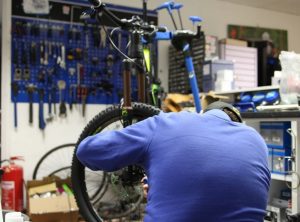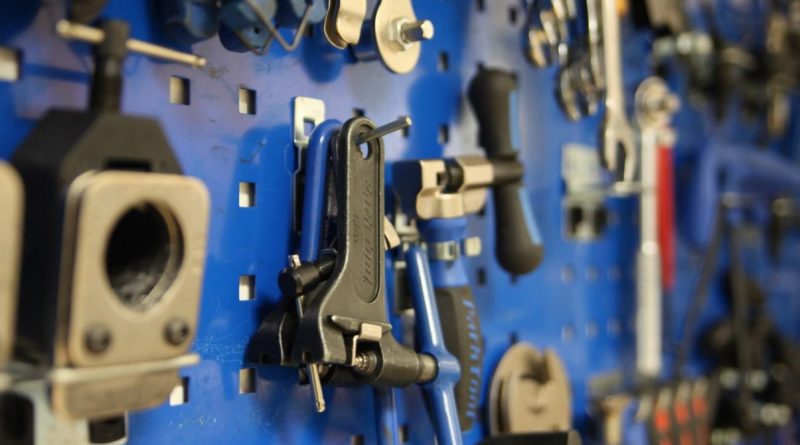Bike shop tips: Building e-bike wheels is a specialist skill and a USP for your mechanic
By Ed Benjamin of eCycleElectric and the LEVA Association
Wire spoke wheels are marvels. The more one learns about them, the more amazing they are. Very light, very strong, inexpensive and versatile.
The wire spoke bicycle wheel has not changed much in basic concept for more than 200 years. For a simple reason – they work very, very well.
And they are not intuitive. Consider the old question of “does a spoked wheel hold the weight suspended from the top spoke as the wheel rotates? Or is the weight standing on the bottom spoke?” Look into it, you may be surprised.
When I was a young bike mechanic in 1969, a normal task for any bike guy was to build wheels for stock. While we might re-lace a customer’s wheel at the bike shop during open hours, stock wheels and difficult wheels would be done sitting in front of the TV in the evenings, with a truing stand, supplies of rims, hubs, and spokes, at hand. It took about 10 minutes to build a wheel.
But along came inexpensive wheels, built by low wage labor, or by machines. These were such good values that we stopped building wheels in the evenings. We bought and stocked ‘generic’ wheels.
And then for many shops, the local bike parts distributor would lace up repair wheels for us. So we stopped doing that in many cases.
There have been other barriers. Spokes are expensive and having a large supply of various lengths of spokes was costly. (And it seemed that we never had the right size in stock…) New sorts of wheels came along that used aero spokes, or lacing patterns that were a big departure from what we had known.
Bike shops and their mechanics stopped building wheels, in most shops. 
(There has been a small group of wheel building experts who have catered to the high-end trade. Often making a pitch that they were artists and what they did was unfathomable to normal bike mechanics. I respect their precise and perfect wheels, but want to encourage anyone who is interested to be confident that you can build a wheel, without micrometers, or decades of experience. Functional wheels are within the grasp of anyone who applies themselves. )
For most bike guys, this was OK. The situation worked for manually powered bikes, in almost all cases. But along comes electric bikes…
Electric bikes are a happy, happy boon to the bike mechanics of the world.
They are pricey, (thus the consumer will spend more on service), get ridden more (thus requiring more service) and they are complex enough that most consumers will defer to a properly educated technician rather than try to fix it themselves.
Electric bikes come in two sorts at this time:
- Hub motor bikes are the most common globally. These may be front or rear hub motor bikes. All hub motor bikes need spokes replaced due to wear, the extra weight, and often, the lack of experience of the bike maker with spoked wheels.
- Central motor bikes that drive the rear wheel much like the rider does. Again these need more spokes replaced due to more miles ridden, and often harsher riding.
(In the USA, it may not be apparent that the central motor units are a small percentage of all the ebikes in the world. Hub motors still vastly outnumber any other system, and will do so for some time yet.)
In both cases, the job usually requires a skilled technician to discover the spoke length, lace in the replacement spoke(s), and adjust the wheel tension. There are no stock wheels that can be used.
When a DIY kit that converts a normal bike to an electric bike needs to be installed, it is often required or preferred, to lace a hub motor into an existing rim. In these cases, a custom spoke length is usually needed.
Broken spokes are normal occurrences on bikes, but more so on electric bikes. And when you need one or two of a unique length spoke for a minor repair it can be expensive and a delay. You need a spoke machine.
So here is the advice of the LEVA Technician Training Program:
If you do not know how to build a wheel. (Fear not, this is not hard).
First: Buy a copy of Jobst Brandt’s book The Bicycle Wheel 3rd Edition read it, and follow his guide to building a wheel. You are following the path of many “wheel building experts” .
And if that is not sufficient, peruse the many YouTube videos (wide variety of quality) on wheel building.
Next: Consult www.ebikes.ca spoke length calculator for the size spoke you need for a hub motor wheel.
Then: Cut your spokes to the correct length on a Wheel Fanatic SCT machine.



